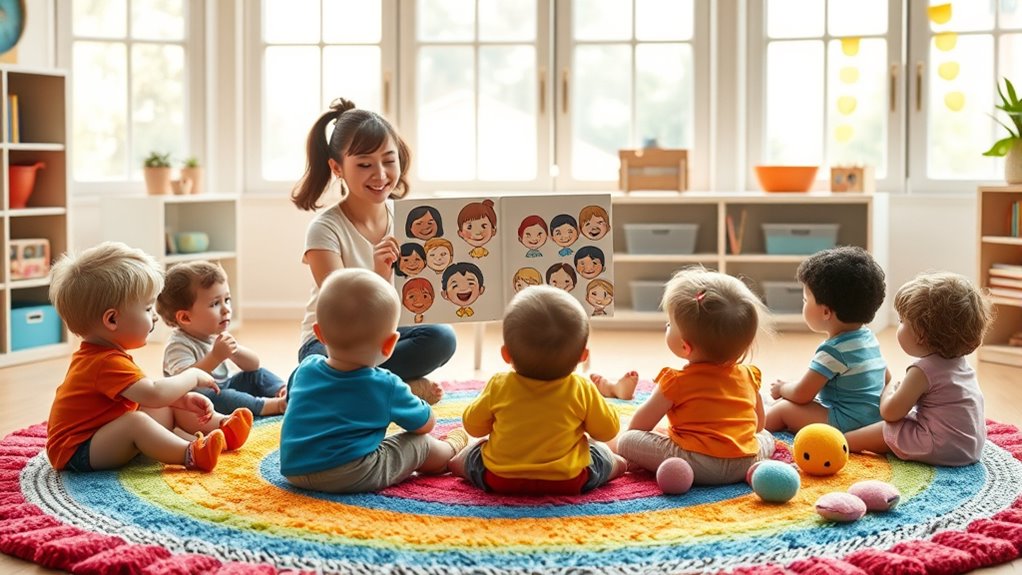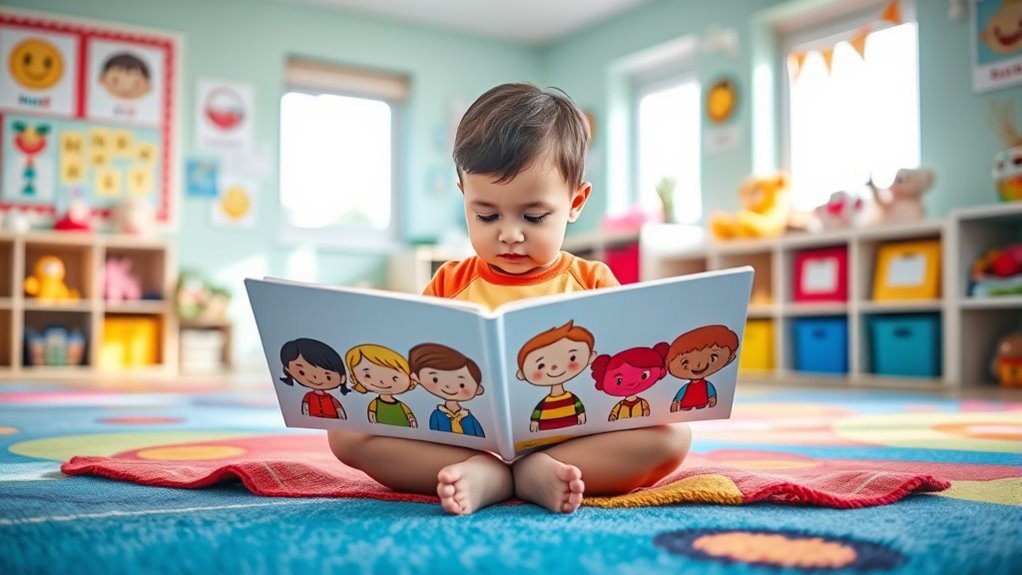You can teach toddlers about feelings effectively by choosing picture books that show clear facial expressions and relatable situations. During storytime, engage them with questions, gestures, and expressive voices to keep their interest. Reinforce learning through activities like role-playing, matching emotions, and discussing characters’ feelings. Incorporate feelings into daily routines, modeling emotional recognition and sharing. Keep exploring methods and resources—they’ll help you support your child’s emotional growth even better.
Key Takeaways
- Choose picture books with clear facial expressions and relatable emotional scenarios to effectively introduce feelings.
- Engage toddlers during storytime with interactive questions and expressive storytelling to enhance emotional understanding.
- Use activities like role-playing and matching games to reinforce emotion recognition and vocabulary development.
- Incorporate daily feelings discussions during routines to foster emotional awareness and empathy.
- Pause during reading to discuss characters’ emotions, encouraging reflection and connecting stories to personal experiences.
Choosing the Right Picture Books for Emotional Learning

How do you select picture books that effectively teach emotions? Start by looking for books with clear visual cues that help children recognize feelings. Bright illustrations, expressive faces, and relatable scenarios make it easier for toddlers to connect with the emotion being portrayed. Guarantee the content is age appropriate; stories should be simple, engaging, and tailored to your child’s developmental level. Avoid books that are overly complex or contain abstract concepts that might confuse young learners. Choose titles that introduce a variety of emotions, so children can see different feelings in familiar contexts. By focusing on visual cues and age-appropriate content, you set a strong foundation for children to understand and empathize with their own emotions and those of others. Incorporating visual cues, such as facial expressions and body language, can also enhance the understanding of emotions in storytime, making the lessons more engaging. Additionally, selecting books that feature emotional diversity can help broaden a child’s emotional vocabulary and social awareness. Recognizing the importance of Vetted recommendations ensures you select quality and effective resources for emotional learning. Including books with emotion recognition, such as identifying feelings through context and imagery, can further deepen a child’s emotional understanding.
Strategies for Engaging Toddlers During Storytime

To keep toddlers engaged during storytime, incorporate interactive elements that encourage participation and curiosity. Use interactive storytelling techniques such as asking open-ended questions, encouraging toddlers to make sounds or gestures, and pausing for their reactions. Sensory engagement is also key—bring in textured objects related to the story, use exaggerated facial expressions, and incorporate vocal variations to capture attention. These strategies make the story more immersive, helping toddlers connect emotionally with the material. Keep the pace lively and adapt your tone to maintain excitement. Additionally, incorporating unique and wicked planters or other playful props can spark children’s imagination and deepen their emotional understanding. By actively involving children in the storytelling process, you foster their interest and deepen their understanding of emotions. This approach transforms storytime into a dynamic, memorable experience that nurtures emotional awareness.
Activities to Reinforce Emotion Recognition and Expression

Building on engaging toddlers through storytelling, incorporating activities that reinforce emotion recognition and expression helps deepen their understanding of feelings. You can use role-playing activities to encourage children to act out different emotions, making feelings more tangible. Emotion matching games are excellent for helping toddlers identify facial expressions and associate them with specific emotions. Consider creating simple scenarios where kids match pictures of faces to emotion words, boosting their vocabulary and empathy. Other effective activities include mimicking facial expressions, matching emotion cards, and sharing feelings through art projects. These interactive exercises make learning about emotions fun and memorable. Additionally, understanding the importance of local resources can enhance the support available for emotional development activities. Incorporating proper planning into your routine can help ensure these activities are consistent and effective in fostering emotional awareness and helping toddlers confidently express their feelings.
Incorporating Feelings Discussions Into Daily Routines

Incorporating feelings discussions into daily routines helps children develop emotional awareness naturally and consistently. You can encourage sharing feelings during everyday activities, like mealtime or playtime, by asking simple questions such as, “How did that make you feel?” or “Were you happy or sad?” Recognizing emotions becomes easier when you point out feelings in yourself and your child, modeling that sharing feelings is normal. For example, if your child is upset, acknowledge it by saying, “You’re feeling frustrated,” and validate those emotions. This regular practice helps your toddler understand and identify their own feelings while learning to recognize emotions in others. Consistently incorporating these conversations can also support emotional development, fostering emotional growth and empathy. Incorporating emotion recognition into routines encourages children to become more aware of their feelings and develop empathy for others.
Tips for Supporting Emotional Development Through Reading

Reading stories with your child provides a natural opportunity to explore emotions and deepen their understanding of feelings. To support emotional development through reading, focus on expanding their emotional vocabulary and promoting empathy building.
- Pause to discuss characters’ feelings and ask your child how they might feel in similar situations.
- Use expressive tone and facial expressions to model understanding and empathy.
- Encourage your child to relate story events to their own experiences, fostering emotional awareness.
- Ask open-ended questions that prompt reflection on characters’ emotions and motives.
- Reinforce new emotion words by repeating and using them in different contexts.
- Remember that understanding the PlayStation Support Hours and other entertainment schedules can help schedule quality reading time during less busy periods, making the experience more enjoyable.
- Incorporating activities that highlight emotion recognition can further strengthen your child’s ability to identify and understand feelings in various situations.
- Staying informed about AI security vulnerabilities can also serve as a model for discussing complex feelings like worry or concern in age-appropriate ways.
Frequently Asked Questions
How Can Parents Assess Their Child’s Current Emotional Understanding?
To assess your child’s emotional understanding, observe their reactions and interactions regularly. Pay attention to their responses to different situations and note any emotional milestones they reach. Use parent observations to identify whether they recognize and express feelings appropriately. You can also engage in conversations about emotions and see how they respond. This ongoing assessment helps you understand their emotional development and guides you in supporting their growth effectively.
What Signs Indicate a Toddler Is Ready to Learn About Feelings?
Imagine you’re watching your toddler closely, waiting for those subtle signs. When they start recognizing basic emotions like happiness or sadness, you’re seeing emotional milestones unfold. Readiness cues include their curiosity about feelings, ability to label simple emotions, and interest in stories about emotions. These signs indicate they’re primed to learn about feelings, opening the door for meaningful conversations and growth in emotional understanding.
How Do Cultural Differences Influence Emotion-Related Picture Book Choices?
You recognize that cultural differences greatly influence emotion-related picture book choices. Cultural storytelling shapes how emotions are expressed and understood, so select books that reflect diverse perspectives and traditions. By doing so, you help toddlers see that emotion expression varies across cultures, fostering empathy and inclusivity. Incorporate stories from different backgrounds to enrich their understanding and promote respect for cultural differences in emotion expression.
Are There Particular Books Recommended for Children With Special Needs?
When choosing books for children with special needs, you should focus on inclusive stories and sensory books that cater to their unique learning styles. Look for titles that promote diversity and understanding while offering tactile or visual stimulation. These books help children connect with emotions, build empathy, and develop social skills. By selecting appropriate, engaging materials, you create a supportive environment that encourages emotional growth and inclusivity for every child.
How Can Caregivers Handle Emotional Outbursts During Storytime Effectively?
Research shows that emotional validation and calming techniques effectively manage toddler outbursts. When a child becomes upset during storytime, you should calmly acknowledge their feelings to help them feel understood. Use gentle calming techniques like deep breaths or a soothing voice. Stay patient, avoid escalation, and remind them it’s okay to feel upset. Your consistent, empathetic response reassures your child, helping them learn to regulate their emotions over time.
Conclusion
By incorporating carefully chosen picture books into your routine, you can profoundly boost your toddler’s emotional understanding. Did you know that children who engage with emotion-focused stories show a 30% increase in recognizing and expressing feelings? Keep the conversation going beyond storytime, and watch your little one develop empathy and self-awareness. With consistent effort, you’ll help them navigate their emotions confidently and build a foundation for healthy relationships later on.










